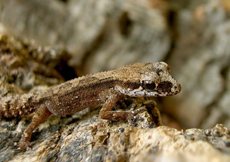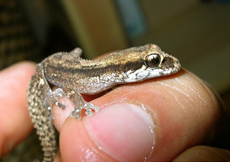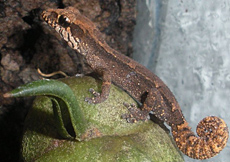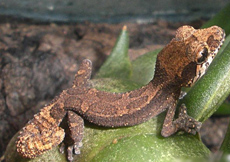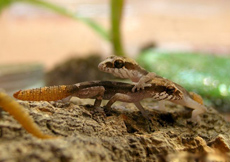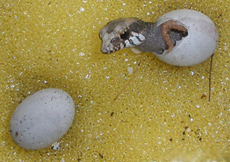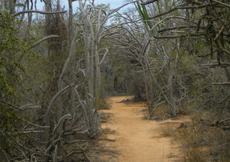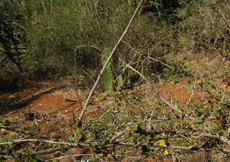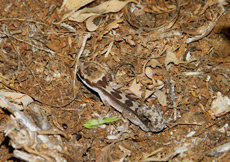Paroedura androyensis
(GRANDIDIER, 1867)
Distribution:
The genus Paroedura can be found together with 13 other endemic species in Madagascar. One Paroedura species (P. sanctijohannis) belongs to the Comoros. Even today new species of this genus are being discovered. Paroedura androyensis occurs in the south and east of Madagascar.
Description:
With a length of up to 7 centimeters, Paroedura androyensis ranks among the smallest members of the genus. Males often remain a bit smaller than 7 centimeters and are characterized by clearly visible hemipenis pockets at the base of the tail. The animals are otherwise indistinguishable between genders. For amateurs a direct comparison between other animals often has to be made because females also have a slightly thickened tail base. The base color of the animal is brown-gray, beige or light brown with some lighter and darker markings. The color of hatchlings often looks very different. Although some adult animals remain bright and some dark, mature animals mostly appear very similar. The under side of the gecko is bright white and patternless. The base color of the throat is white and is covered with dark brown to black stripes. The dorsal markings consist of a beige-gray diamond pattern that runs all the way from the neck down to the tail. The sides of the gecko are dark brown. The noticeably thick and strongly curled tail is brighter than the rest of the body.
Habitat:
Paroedura androyensis live in primary and secondary forests. They are found mainly in the leaf litter, at the base of trees or root areas. The species is found in deciduous forests with pronounced dry and rainy seasons. Temperature fluctuations are scarce and it can be very warm on the ground.
Husbandry and Breeding:
The Madagascan big-headed geckos are enjoying great popularity amongst terrarium keepers due to their classic "gecko-shape" with big eyes, childlike face and characteristic feet. In addition to the more commonly kept and bred Paroedura picta; Paroedura bastardi, P. masobe, P.sumpffi and P. vazimba are also found in the terrariums of German keepers. Paroedura androyensis is not easily obtained and it is even more rare to find captive bred specimens of this beautiful animal.
One male and two to three females can be housed problem free in a terrarium with a ground measurement of 60x40 centimeters. The enclosure should contain a lot of hiding locations and plenty of structure via rough cork tubes, climbing branches and bark. The side and rear walls should be decorated with a more smoother material as this is more preferred by the geckos when ascending. Planting is up to the keeper.
Every 3 to 4 weeks the female will lay a double clutch, the clutch will be buried two to seven centimeters deep in the soil. Sometimes eggs are placed under bark or in leaf litter, these are usually unfertilized. It is important to note that if the soil in the enclosure is kept too humid the females may have difficulty in choosing a suitable egg laying spot, resulting in egg binding, so some sections of the soil should be kept dry at all times to help aid in problem free egg laying. It is best to remove the eggs from the enclosure to an incubator, as the parents have been known to go after their young, especially their tails. When removing the eggs, care must be taken when handling the eggs because they have a very fine shell. Incubation temperatures of 25-30°C (77-86°F) has resulted in the offspring emerging between 65-90 days. It has been noted by some keepers that higher incubation temperatures result in more males and lower temperatures result in more females. Offspring should be reared separately, but can be kept in small groups if fed often enough, failure to provide enough feeders for each offspring will result in missing tails or death of others.
It is especially important for the well being of females and their offspring that all animals are fed a well varied diet. Breeding females also need to have the possibility for calcium uptake at all times, so a small bowl of cuttlefish bone should not be missing from the enclosure! Favored prey of Paroedura androyensis are woodlice, Thermobia domestica, small crickets and field sweepings.
Due to their highly active nature Paroedura androyensis can easily be observed in the evening and night. Many of their "emotional feelings" can be determined by observing the tail, nightly hunting shows the tail in a curled up state, which is usually lifted up above the abdomen and wagging can be an indicator of stress or threat.
Paroedura androyensis often always holds itself up highly on their legs and is usually quite slow. In dangerous situations, or while hunting they can be very nimble and agile. If you catch an animal, it will often voice its displeasure by opening their mouth wide and barking. Rarely conflicts between the animals result in this same vocalization.
Despite many descriptions that Paroedura androyensis is a ground-dweller, these geckos have more been observed traveling on branches and the walls of their enclosure. Tubes and cave hideouts lying on the ground are usually not accepted, instead the animals sleep in a more upright position in crevices of the back and side walls or any cork tubes left leaning against the enclosure walls. Adult animals prefer rougher surfaces such as cork bark for climbing, while hatchlings will utilize the special tiny adhesive hairs on their feet to move on glass and other smoother surfaces. Contrary to many opinions found on forums the females are a lot more stable than led to believe. Those observations are probably mainly due to weakened health of wild caught animals or animals not fed a well varied diet.
Co-housing (by more experienced keepers) in larger terrariums with dwarf day geckos, such as Lygodactylus williamsi or Gonatodes ocellatus has shown itself to be problem free.
